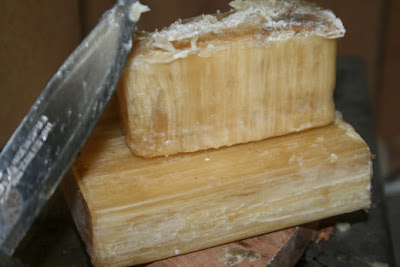BEFORE :
Here is my kitchen counter (made of unfinished hickory wood planks) before applying my wood oil recipe...
 In order to prevent alot of staining plus possible mold and mildew growth on the unfinished wood, especially during the summer months I decided to 'stain' or oil the wood with a natural recipe - one that was 100% non toxic, that would not out gas, and would be safe for those people who are sensitive to the chemicals in commonly toxic wood finishes.
In order to prevent alot of staining plus possible mold and mildew growth on the unfinished wood, especially during the summer months I decided to 'stain' or oil the wood with a natural recipe - one that was 100% non toxic, that would not out gas, and would be safe for those people who are sensitive to the chemicals in commonly toxic wood finishes.SUPPLIES :
- Bees Wax
- Walnut Oil
- S alt
- Apple Cider Vinegar
- Knife
- Stirring Spoon
- Pot to cook it in
- Rag, sponge or some type of tool to rub the oil into the surface
 The first thing I had to do was cut a portion of the bees wax off, which luckily my friend Gabi gave me the awesome tip to heat up the knife first then cut into it "like buttah"...
The first thing I had to do was cut a portion of the bees wax off, which luckily my friend Gabi gave me the awesome tip to heat up the knife first then cut into it "like buttah"...Mine was super thick so, I had to re-heat it a few times until about 1/4 of the pound of wax broke and I had the perfect piece to add to my recipe.
NOTE: I recommend using bees wax and not a white food grade wax because of the coloring when it dries, and general coloring added to the recipe. Bees wax is also easier to work with and has a good smell!
 ADD TO THE POT:
ADD TO THE POT: 2-3 cups Walnut Oil, 1/2 cup Salt, chunk of Bees Wax, teaspoon of Apple Cider Vinegar... And bring to a boil till the wax is fully melted into the mixture and stir occasionally.
This is totally experimental amounts - if you add alot of wax the mixture will become so wax-y that it will be too thick a coating on the wood... if anyone has 'buffing tips' for a more wax heavy mixture please share!
 After the wax is melted, rub it into the wood while warm...
After the wax is melted, rub it into the wood while warm... Rub the wax in a buffing fashion, and be sure to not drip too much or lay it on thicker in various places... when using a mixture with wax you do have to be conscience of layering it evenly.
Rub the wax in a buffing fashion, and be sure to not drip too much or lay it on thicker in various places... when using a mixture with wax you do have to be conscience of layering it evenly. Looks awesome and smells edible.... but it could use a little extra buffing ---> so i am looking for suggestions of what would be a good material or tool to use for buffing this kitchen counter?
Looks awesome and smells edible.... but it could use a little extra buffing ---> so i am looking for suggestions of what would be a good material or tool to use for buffing this kitchen counter? In the meantime, I LOVE it!!! I love it so much I can't stop putting that stuff on everything wood around the house. :) The bathroom floor is next!!!
In the meantime, I LOVE it!!! I love it so much I can't stop putting that stuff on everything wood around the house. :) The bathroom floor is next!!!Kiss This HOuse BEAutiFUL!
 Xoxoxo
Xoxoxo











6 comments:
if you use more coats with more oil it will last longer and penetrate deeper. you can add a bit of pine pitch to the mix to make it harden up a little more. and it smells good with the beeswax.
after you get a few coats rubbed in buff it with fine steel wool. when you have enough coats that steel wool rubbing gives you a sheen, "spit shine" it with cold water and a cotton balls or a soft cotton cloth.
use the same rag for oiling every time you recoat. it will just get better with time. you can also warm it a little and it's good for a quick rub down. this helps keep it from getting any build up too.
are you double boiling your ingredients? beeswax has a melting point of around 145. it discolors at 185 and catches fire around 400. wood burns at around 700 to give you an idea how easy it lights up. i almost burned the kitchen down melting crayons when i was 7.
hope that wasn't your good knife you heated up. i heat up a cheapo steak knife to cut my wax.
have you considered milk paint? though i'm partial to wood looking like wood.
1870 Milk Paint Formula
1 Quart skim milk (room temperature)
1 Once of hydrated lime by weight
(Available at building centers. Do not use quick lime, as it will react with the water and heat up. Hydrated lime has been soaked in water then dried.)
1 to 2 1/2 pounds of chalk may also be added as a filler.
Stir in enough skim milk to hydrated lime to make a cream. Add balance of skim milk. Now add sufficient amount of powder pigment to desired color and consistency (Pigment powder must be limeproof). Stir in well for a few minutes before using. For best results continue to stir throughout use. Apply milk paint with a cheap natural bristle brush. Allow project to dry sufficiently before applying next coat. Extra paint may be kept for several days in the refrigerator, until the milk sours. Double or triple the recipe for paint. Allow to dry thoroughly 3-4 hours before use. For extra protection, give paint a coat of oil finish or sealer. Color may change - test in inconspicuous area.
there are many recipes for milk paint. this one came from here > http://www.realmilkpaint.com/recipe.html
Hey Panne!
I like the look of wood, and I also realllly love milk paint alot. But for the kitchen counter i wanted to stay with the wood theme (i will be using milk paint on the bathroom door(s) i am putting up which will be two shutters).
I boiled the oil, then melted the wax and turned down the temperature - and applied it warm enough that i could easily spread it and rub it evenly into the wood.
Pretty sure it did not get to 400 degrees since it didn't catch fire ;) It also had to have cooled down enough to touch my fingers before i rubbed it in with the cotton rag.
your milk paint recipe seems really easy! do you know of a good place to buy natural pigment that won't react with the lime?
Leslie! It has been awhile since I checked in and I don't have much concentration, but this is beautiful. I am so happy for you. Good job! (But you know that.)
I'll trade you some extremely well-seasoned cast iron pans for that kitchen faucet.(The pans are guaranteed to be 100% non-stick without the nasty chemicals, I figured out a trick to season them with safflower oil-it's all about the physics)
i don't know much about pigments. i only know of a few folks that used the milk paint for things that needed to be hidden. sometimes wood gets stained before you can seal it.
i forgot to mention that you can use a white wash or wall paper brush with natural bristles to spread it out. just stay away from the ones with the spaces between the bristles that look similar to a hair brush.
Hey Canary!
So sorry you are not feeling well, did something happen? Thanks so much for the compliment, you and me always do similar cool projects :)
Mr. Cheese --->
My kitchen counter was left over floors, the support leg was a log in the woods, and even the nails were already here and the sink was too......
BUT that faucet is new and looks old because it's oil rubbed bronze - all the faucet fixtures in my house are oil rubbed bronze, some from e-bay, some from Lowes (i don't mess around with too much old plumbing cause leaks cause grosser mold probs.
I bet your cast iron pans are worth more then my faucet, but you can find it on Lowes.Com under the kitchen sink faucets :)
BTW- i have been hankering for some seasoned cast irons pans, LEHMAN's has these awesome ones, even a waffle maker that you can put on top your wood stove!
Post a Comment